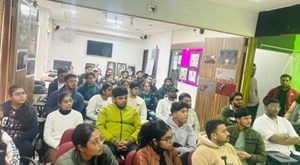Bhubaneswar, 9th June, 2025: Manipal Hospital Bhubaneswar recently triumphed over one of the most complex and life-threatening hematological cases, successfully treating a 20-year-old male from Indore, Madhya Pradesh, battling a cluster of rare and fatal bone marrow-related conditions.
Mahesh [name changed] had been experiencing recurrent fainting episodes, persistent fever, and blurring of vision for over a month. He originally sought medical help in Indore; however, despite multiple consultations at different hospitals, his condition continued to worsen without a clear diagnosis. He then, after discussing with his family, moved to Cuttack – his parents’ house for further treatment and explored treatment options at Manipal Hospital Bhubaneswar.
At the hospital, a thorough evaluation was carried out, where his blood parameters were found to be dangerously low, an extremely concerning situation for someone so young and previously healthy. He was immediately admitted under the care of Dr. Sandeep Abhijit Pattnaik, Consultant -Department of Clinical Haematology and Bone Marrow Transplant. While initial investigations didn’t reveal any definitive etiology, his bone marrow reports uncovered a complex and rare mix of health issues: a loss of characteristic myeloid antigens called secondary myelodysplastic syndrome, along with bone marrow tuberculosis, bacterial infections caused by E. coli and Pantonea, fluid build-up around organs (polyserositis), and a rapidly worsening condition called hemophagocytic lymphohistiocytosis (HLH).
Exclusive extrapulmonary TB of the bone marrow, especially when combined with myelodysplasia and HLH, is an extremely rare and near-fatal condition. Recognizing the critical need for a nuanced approach, a multidisciplinary team led by Dr. Sandeep Abhijit Pattnaik, which included Dr. Subhashree Samantray, Associate Consultant – Infectious Disease, Dr. Sambit Kumar Bhuyan, Consultant – Medical Gastroenterology, and Dr. Pradeep Narayan Sahoo, Consultant – Internal Medicine opted for a structured, protocol-based treatment strategy.
Dr. Sandeep Abhijit Pattnaik noted, “HLH requires immediate administration of heavy-dose steroids to manage the immune overactivation. However, in this patient’s case, it was not possible due to his already fragile condition, given the presence of multiple infections, especially tuberculosis and E. coli.”
The treatment approach began with targeted high-end antibiotics and anti-tubercular therapy with continuous monitoring of acute-phase reactants and inflammatory markers. Against all odds, Mahesh made a remarkable recovery within just 10 days of continuous therapy. His blood counts returned to normal, his symptoms resolved, and he was discharged in stable condition.
Dr. Saktimaya Mohapatra, Hospital Director, Manipal Hospital Bhubaneswar, noted, “Our priority has always been delivering quality, personalized care. This case underscores our hospital’s capabilities in managing rare and high-risk conditions through timely diagnosis, precision medicine, and expert interdisciplinary coordination.”
Currently, Mahesh is under follow-up with no minor or major health issues and is on his way to a complete recovery and good health.
 Newspatrolling.com News cum Content Syndication Portal Online
Newspatrolling.com News cum Content Syndication Portal Online






